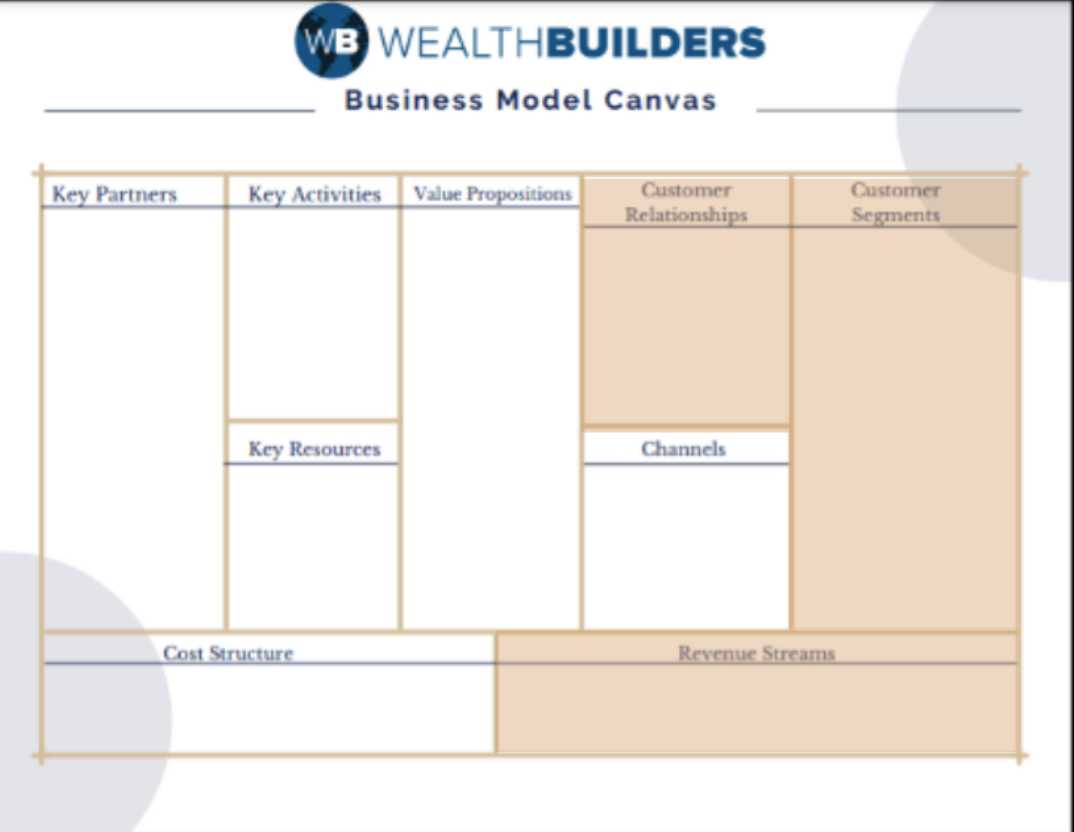Are you an active or aspiring entrepreneur who wants to connect with your customers better (and monetize those connections?) If so, the customer segments, revenue streams, and customer relationships portion of the Business Model Canvas is a great tool that can help you achieve those goals.
To recap, The Business Model Canvas is a one-page business plan. It’s a great first step to springboard you into the latter stages of building a business. Every block in the Business Model Canvas is key, and it simplifies the somewhat overwhelming process of creating a business plan.
The first blog post in our series on The Business Model Canvas covered unique value propositions. To recap, a value proposition describes the value a product or service offers to a consumer should they choose to purchase it. This blog post will cover:
- Customer Segments
- Customer Relationships
- Revenue Streams

To download a free Business Model Canvas template, click here.
Customer Segments
A customer segment is the group of people who benefit from your value proposition. Ask yourself the following questions to get a better understanding of your customer segment(s):
- Who is benefiting from the usefulness of my product or service?
- Who is my ideal customer? (Some customers are more valuable than others!)
Four ways to determine your customer segment(s):
1. Demographics: Classifying consumers based on socioeconomic information expressed statistically, such as age, gender, income (who can afford your product or service?), marital status, race, ethnicity, education, and employment status.
- It’s not that you don’t want to (or won’t) receive business from people outside your target demographic. However, by its nature, your product or service will appeal to a certain demographic more than others. Being mindful of these qualities helps you hone down on your ideal customer and save on your marketing budget.
2. Psychographics: Classifying consumers based on psychological factors, such as spiritual beliefs, values, personality, attitudes, aspirations, and opinions
- You need to understand what the people you’re marketing to are like on a psychological level. Psychographics allow you to market your product or service according to your customers’ values. Purpose-driven and social impact marketing is on the rise, as consumers are increasingly using their purchase power to support companies that align with their beliefs.
3. Behavioral: Classifying consumers based on their habits and tendencies.
- For example, does your customer segment exercise frequently? Perhaps they’re parents who actively help their kids with homework, and your product or service can help with that. Maybe your customer segment frequents church and religious spaces. The goal is to leverage those behaviors to reach your customer segment.
4. Necessary Jobs: Consider all the work that needs to be done in the lives of those in your customer segment. Perhaps they need to manage a family, or maybe they want to excel at work and are looking for professional development resources. Having an understanding of the responsibilities your customer segment needs to fulfill can help you identify core issues in your target market. This makes marketing efforts more focused and effective.
For example, I used to own a home staging business. In order to identify someone who would use home staging services—a potential customer segment–I launched an experiment.
Right off the bat, I knew that real estate agents were my main target market because they were the professionals who people looked to for advice. In other words, they were near the top of the funnel. However, not every real estate agent understood the value of home staging. So, I found a way to reach the agents who did. I offered a continuing education class on home staging. Obviously, the real estate agents who signed up for my class valued home staging, or they wouldn’t have joined.
Revenue Streams
“The difference between a good idea and a business model is verifiable and reoccurring revenue streams.”
Revenue streams are the various ways an organization earns money. The main problem that businessowners face can be boiled down to this: they aren’t receiving enough revenue to actualize their vision. They may have a good idea, but it isn’t getting enough financial traction.
When considering the revenue streams in your business, ask yourself the following questions:
-
What are your customer segments willing to pay?
You need to determine the price that reasonably corresponds to the product or service you’re offering. Do market research to evaluate the price scale of similar businesses. In some cases, you can create new market value. For example, paying over $5 for a cup of coffee used to be unheard of. Then, Starbucks created and popularized a need for specialty coffee like lattes, mochas, and frappuccinos. They had to compare existing market research to the new product they were offering and determine a cost structure. It’s important to ask yourself this question in the front end so you can compare the cost structure later. This will help you evaluate your business’ potential profitability.
-
What capital do you need to operate?
Entrepreneurs are passionate, so they often want to undertake projects and tasks that aren’t necessarily attached to a revenue stream. Ensure that you aren’t consuming more resources to contribute to a revenue stream that doesn’t actually provide a financial return.
-
What is your point of sale?
At what part of the process will people pay for your product or service?
-
How big is each revenue stream?
After you complete the BMC, it’s wise to fill out the Boston Matrix. On it, you’ll plot the revenue streams you listed on the BMC to determine which stream has the most potential in the shortest amount of time. You want to hit the point of profit as early as possible so you can have more capital to grow.
-
Do you have more than one customer segment calling for multiple revenue streams?
There are varying levels of customer segments depending on where their influence is. For example, are they a purchaser? Or, are they a person people go to for referrals? Is there a wholesale level? We want apply the majority of our energy to the revenue streams that reach the most customer segments.
8 Examples of Revenue Streams
- Asset Sales— Generated from the transfer of ownership rights of a good or service. (Example: buying a cup of coffee or purchasing a car)
- Rental Fees— Generated by temporarily granting someone the exclusive right to use a particular (physical) asset for a fixed period in return for a fee. (Example: A car rental service)
- Usage Fees— Generated by the use of a particular service. The more the service is used, the more the customer pays. (Example: Ubers/Taxis)
- Subscription-Based– Generated by using continuous access to a service. (Example: Our online learning subscription site, WealthBuilders University)
- Lending, Renting, and Leasing— The exchanging usage of a property you own for a fee. (Example: passive income generated through buy and hold real estate)
- Licensing Fees— Generated by giving customers permission to use protected intellectual property in exchange for licensing fees. (Example: Major League Baseball teams get paid every time someone uses their logo.)
- Brokerage Fees– Generated from intermediation services performed between two or more parties (Example: An insurance broker or real estate broker)
- Advertising— Generated by using your business as a platform to give visibility to a particular business or service (example: monetized blogs, popular YouTube channels, billboards, etc.)
Each business should have at least two revenue streams. It helps to have one recurring stream, such as renting and leasing, as well as a one-time revenue stream that provides a cash infusion, such as fix and flips.
“A product solves an individual need. A real business has something customers will come back for again and again.” –Eric Holtzclaw, serial entrepreneur
Ask yourself: Do you have revenue streams available for your customer segments beyond the initial purchase? Is there a reoccurring need for your product or service?
Customer Relationships
Customer relationships are how you connect with your customer segments. In this section of the Business Model Canvas, it is important to try and evaluate the type of relationship your customers would like to have with your company. Come up with a customer relationship for each customer segment.
As previously mentioned, real estate agents were one of the primary customer segments for my home staging business. Their ideal customer relationship entailed someone who made their listed homes look great so that they could sell them faster. In addition, they wanted someone who was self-sufficient, trustworthy, efficient, and could communicate well with their customers. So, the primary value I added to that customer relationship was ease. As a licensed real estate agent and home stager, I could get access to the real estate agents’ listings so they wouldn’t have to inconvenience themselves to let me into the homes.
3 Questions to Help You Determine Customer Relationships
1. What are your customer segments looking for in terms of customer service?
- For instance, is proximity important? Do they want 24/7 phone and chat support?
2. What customer relationships exist, and what are the costs of them?
- Maintaining relationships cost time and money. For instance, if you need to be readily available, there may be spur of the moment time and financial costs. Or, if you need to stay connected to your customers via social media, you may have to shell out cash for programs that schedule posts and a social media manager.
3. Do your customer relationships currently reflect your customers’ needs?
- Be aware of the changing needs of your customers!
I hope this post gave you a better understanding of how to construct your initial business plan using the Business Model Canvas. To download a free Business Model Canvas template, click here.
If you want to learn more about how to start your own business, we created The WealthBuilders Business Development and Nonprofit Workshop just for you! You’re invited to join us August 19-21 in Denver, Colorado. Click here to register.



